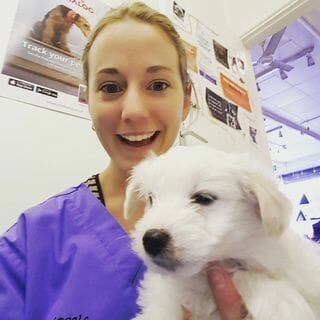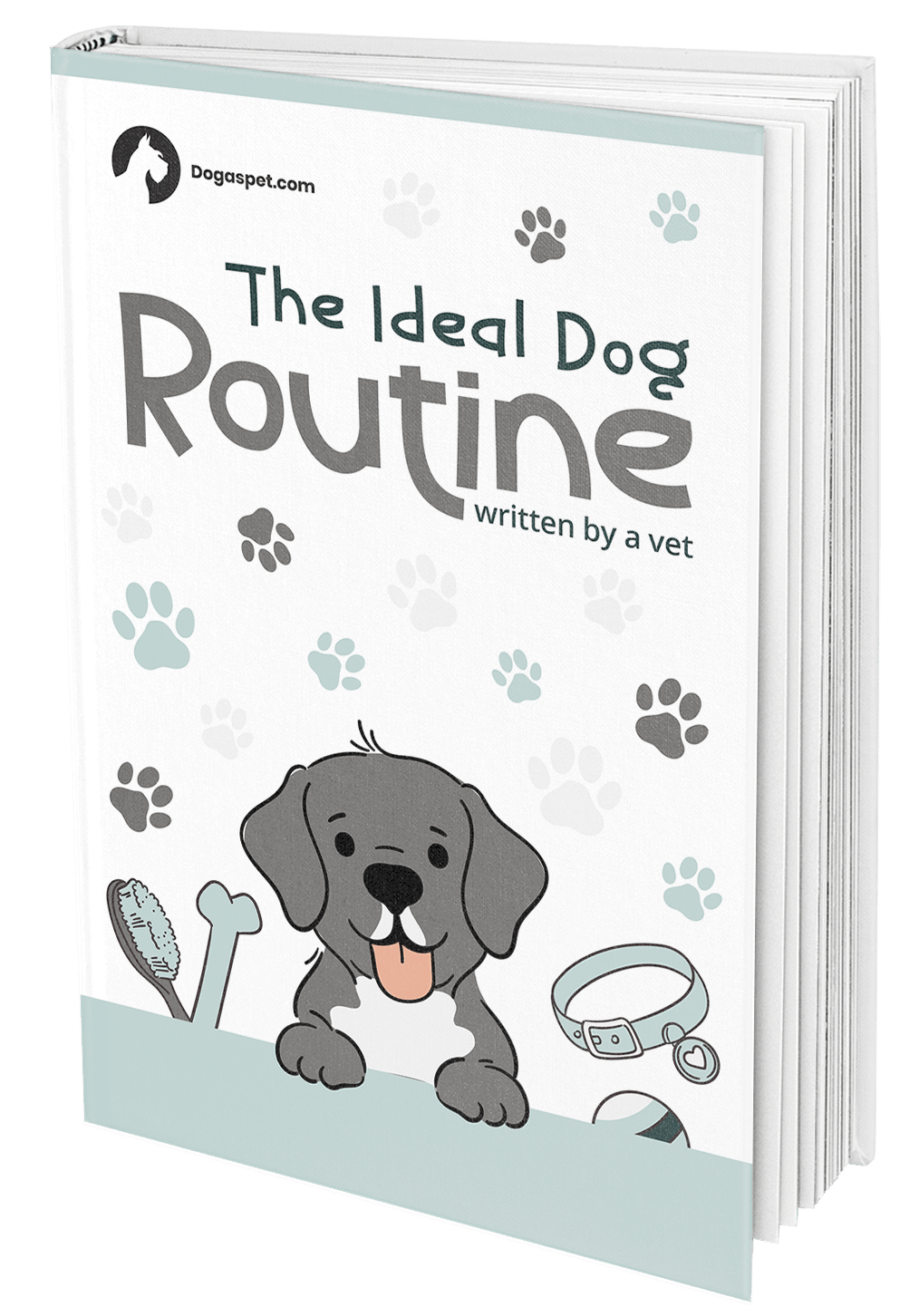
As a vet, many owners will approach me wondering what they can do to get their dog to the optimal body condition score. Dogs should be lean and well-muscled, without an excess of fat build up.
In developed countries like the USA, England and Australia, it is much more common for a dog to be overweight than underweight. However, when a dog is truly underweight, we need to work with them to help them get to their ideal body condition.
Table of contents
Why is my dog underweight?
It’s important to state that if a dog is losing weight or seems to be skinny for no obvious reason, this is something to discuss with their vet. For many animals, this will be an indication of an underlying medical issue. This is especially true if they have other symptoms such as vomiting, diarrhea, bloating, or lethargy.
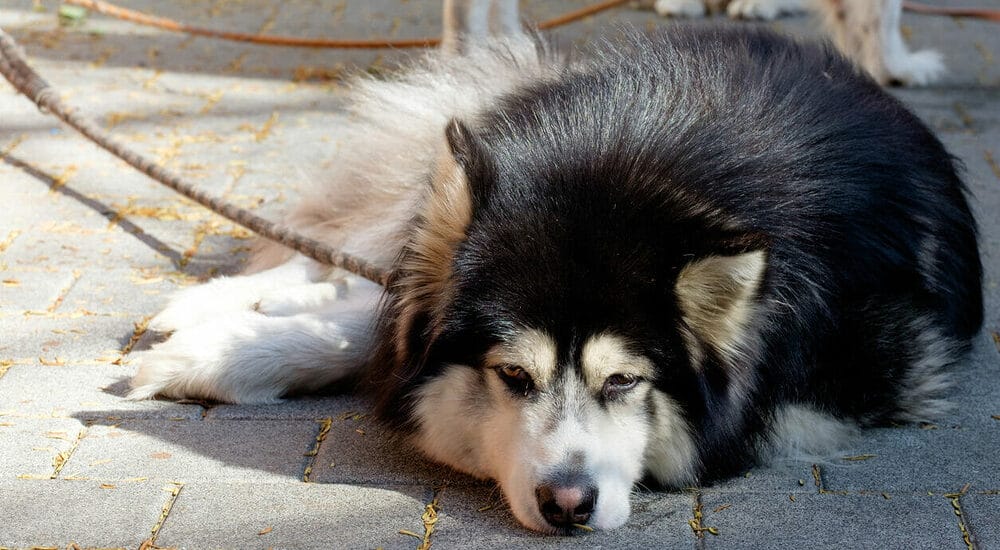
Medical conditions that can cause a failure to thrive are vast and varied. They would include food allergies, malabsorption disorders, Exocrine Pancreatic Insufficiency (EPI), cancers, hormonal disorders, liver disease, heart failure, etc.
When a young dog or puppy is underweight, one of the most common causes will be internal parasites such as worms. We can also see a failure to thrive when they have an infection or when they’re being underfed or being given an inappropriate diet.
Remember, an underweight dog or one who is losing weight should be seen for a veterinary check-up before we decide on the best diet for them. So, if looking for some home remedies to get your dog to gain weight, ensure they’ve got a clean bill of health first.
Can stress play a role when it comes to food intake and appetite?
Absolutely, for some dogs, stress can be a contributing factor to their struggle to gain weight. Many dogs won’t eat when stressed or depressed, and this can lead to weight loss.
It helps to offer our dogs a consistent routine and to ensure they’re homelife is calm and predictable. If they dislike eating around other pets, they should be given a space where they can dine alone and in peace.
When would a dog need ‘fattening up’?
It is actually not all that common for dogs to need fattening up. Indeed most have quite the opposite issue, and are over their ideal weight! However, we may need to bulk up a new rescue dog that has come to us, or a pet who is getting over an illness.
We can tell a dog is too skinny if they have visible and prominent ribs, a very slender waist, a tucked-up tummy, and a lack of muscle mass. Underweight dogs might also be lethargic and can struggle to keep up when exercising.
Having an underweight dog can be a real source of stress and many owners feel judged and ‘stared at’ when outside with their pet. For most dogs, however, it’s a very temporary issue that’s easily resolved.
What are some high-calorie foods?
A dog’s diet should consist mainly of a protein source (such as meat or fish), fats (such as salmon oil or chicken fat), carbohydrates (such as rice, oats, or sweet potato), vitamins, and minerals. We can also add some nice ‘extras’ such as joint supplements and probiotics as needed.
Some of the higher calorie options when it comes to a protein source would include oily fish like salmon, mackerel, and herring as well as ground pork and chicken thighs.
Fats are a great source of calories and are energy dense. Not only this, they are highly palatable, so this encourages dogs to eat their food as it will be extra tasty.
Sweet potato and pumpkin are both delicious options for carbohydrate sources. They’re also rich in fibre, helping your dog feel fuller for longer and ensuring their stools are nice and solid. This is especially important for dogs dealing with sloppy or loose stools.
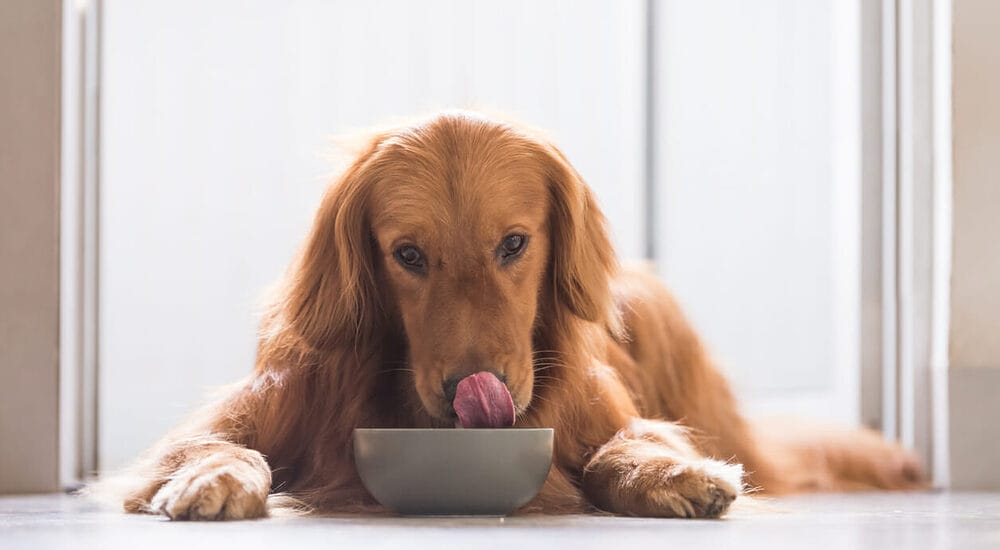
Are there any high-fat foods I should avoid?
Our pets should never be offered high-fat foods like greasy meats, gravy, bacon, and confectionary. These foods can cause stomach upset and could even lead to a life-threatening disease called pancreatitis. While any dog can develop pancreatitis after eating too much fat, breeds including the Schnauzer, Cocker Spaniel, Terrier, and Poodle are most at risk.
Dairy products including cream, cheese, and butter are also big no-nos. Adult dogs are usually lactose intolerant and feeding dairy can lead to signs including bloating, flatulence, diarrhea, and vomiting. So, while these foods may have many calories, they should be avoided.
What are satin balls for dogs?
When researching how to fatten up your dog, you may have come across something called satin balls. This is a specific type of meatball that is high in fat and calories, designed to fatten a dog up.
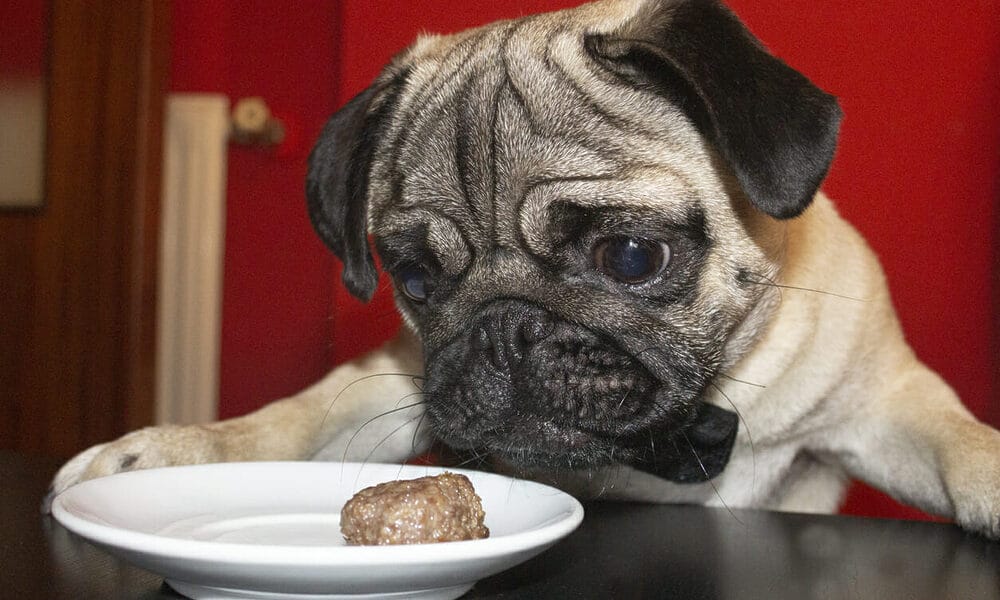
These meatballs can contain ingredients including oats, molasses, wheat germ, coconut oil, egg and ground beef. Some owners also include egg shell, for an extra calcium hit. Satin balls are often touted as the best homemade weight gainer for dogs
These balls are fed raw or cooked. Personally, I’m not an advocate of raw feeding as the raw beef can contain bacteria including Salmonella and E coli, which could make both the pets and the people in the household unwell.
Due to the high-fat content of these balls, they are not advised for those prone to sensitive stomachs or who have had previous episodes of pancreatitis. They are also not suitable for puppies, who may struggle to digest them effectively.
Satin balls dog food recipe
Here is a great tried and tested recipe for these tasty and calorific snacks:
- 1 kilo high-fat beef mince (do not opt for ‘lean mince’)
- 100 grams Bran Flakes (with no added sugar or sweeteners)
- 300 grams instant oats
- 85g wheatgerm
- 1/3 cup vegetable oil
- 1/3 cup molasses
- 2-3 eggs with shells on
- Small amount of gelatin for consistency, if desired
- Cup of parsley for flavor, if desired
All of the ingredients are mixed well in a bowl using a spoon initially and then your hands. Do remember to wash hands well after, with hot soapy water, to remove any bacteria from the raw meat.
The balls can be baked in the oven at 200’c for 15-20 minutes after being drizzled with a small amount of olive oil. They can also be frozen raw for later use.
Are Satin Balls suitable for every dog?
These balls are usually fed to larger breeds who are struggling to gain weight, including German Shepherds, Great Danes, Dobermans and Mastiffs. Smaller breeds can eat them too but would only need small amounts.
How often should I feed my dog and do they need snacks?
How often a dog needs to eat depends on their age, size, and activity levels. A smaller and less active dog may only need one meal a day, while larger dogs tend to do better with two. Young dogs less than the age of four months need to be fed 3-4 times a day.
We can give snacks or treats, but they should not make up more than 10% of a dog’s total calorie requirement. This is to ensure their diet is balanced and that they’re eating enough of their actual dog food.
Some great high calorie snacks include:
Peanut butter
This is a perfect option for putting inside food toys like Kong and lick mats. Just make sure it is a variety with no added salt or xylitol.
Jerky
What dog doesn’t love a bit of meat jerky? Made from meats such as beef and elk, jerky packs a protein punch. Opt for high quality jerky with no additives or preservatives.
Marrow bones
Marrow bones are super high in calories and most dogs go crazy for them. Owners who choose to feed bones must be aware of the potential risks including tooth fractures, choking, gut obstuctions and constipation. A dog should always be monitored when eating bones.
What about pig’s ears, hooves and raw hides?
You may have heard of these high calorie snacks and are perhaps wondering if they’re a good option for your dog. The truth is, they are a controversial treat. These types of chews can do more harm than good.
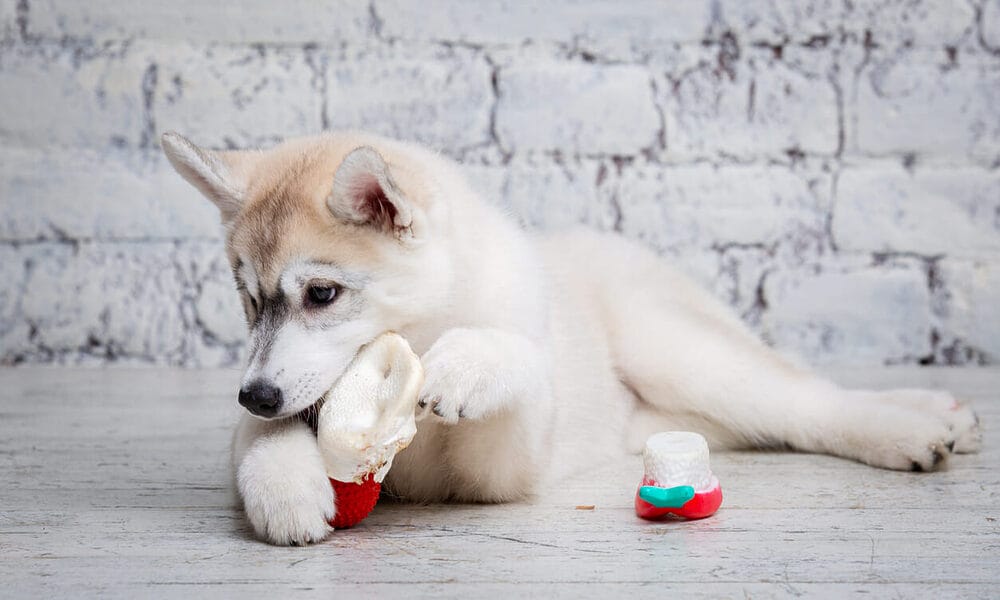
Pig’s ears might be okay as an occasional treat for a large breed, but their very high fat content means an upset stomach is not an uncommon after effect.
Raw hides have developed a bad reputation because they’ve been associated with choking incidents as well as gut obstructions. These events are more likely to occur when a dog swallows large chunks whole.
Animal hooves are not advised as they’re known for splintering and causing injuries within the mouth, food pipe and gut. The keratin is not something a dog can easily digest.
The benefits of homemade diets
Feeding a homemade diet is a commitment that some dedicated owners are willing to make. Doing so ensures you know exactly what your dog is eating and that you have full control over the nutrients they ingest. It can take a lot of time and energy, but you will reap the rewards and your dog will thank you for it.
Offering homemade diets is a great way of avoiding any of the ‘nasties’ of store-bought and commercially made foods, such as preservatives, artificial flavors, artificial colors, and fillers.
When we make our dog’s food from home, we can use fresh cuts of meat and fish, avoiding by-products that can be found in commercial dog food, such as wings, beaks, feathers and offal.
- Full control over what your dogs ingest
- You Avoid Commercially made foods with perservatives, artificial flavors, artificial colors, and fillers!
- With homemade food, you can use fresh food that is more nutritient-dense
The drawbacks of homemade diets
Frustratingly, it is not easy to create a homemade diet that is balanced and provides all of the required nutrients for our dogs. One study showed that a whopping 90% of online recipes for dogs are not nutritionally balanced and could be dangerous if fed long-term.
Oftentimes, homemade dog foods lack key nutrients including calcium and iodine. Many owners do not realise that vitamins and minerals need to be supplemented and that a dog’s nutritional needs change throughout their lifetime.
A diet of, for example, chicken and rice and vegetables, is not actually a balanced diet. Many owners end up feeding fussy dogs a diet similar to this, and these dogs can then go on to develop nutritional deficiencies.
- Difficult to create a balanced homemade diet
- Your dog can develop nutritional deficiencies
So, what’s a good diet to help my dog gain weight?
The best diet depends on the individual! A large Great Dane will need a completely different diet to a tiny Chihuahua. Dogs also have different nutritional needs when pregnant, lactating, unwell, young and elderly.
Once your dog has reached their target weight, they diet will be altered so that this can be maintained. We would not want them to continue to gain weight and to become overweight.
Using a canine nutritionist
To determine what the best diet for your pooch is, the best thing that you can do is to set up an appointment with a canine nutritionist. They’ll assess your dog and their lifestyle, and then make a tailored diet plan for them. Remember, this plan will change as your dog gets older and their needs evolve.
If your dog is under-weight, the nutritionist will ensure they get more than the recommended amount of calories initially. When they develop the high-calorie homemade dog food, they’re likely to use higher fat and protein foods including beef, pork, oily fish and oils such as coconut oil, olive oil and fish oils. It can be a fine balancing act between offering a high calorie diet and causing a stomach upset.
Your vet should be able to direct you to local canine nutritionist that come recommended. Remember to double check their background and qualifications, and to ask for reviews from other owners.
